Abstract
Background
Laparoscopy generates technical and ergonomics difficulties due to limited degrees of freedom (DOF) of forceps. To reduce this limitation, a new 5-mm robotized needle holder with two intracorporeal DOF, Jaimy®, has been developed. The aim of this study was to evaluate its effects on ergonomics and skills.
Methods
Fourteen surgeons including eight senior and six residents were crossover randomized and stratified based on experience. Three suturing tasks were performed with both Jaimy® and a classic needle holder (NH): task 1: Peg-Board; task 2: hexagonal suture; task 3: frontal suture. Postural ergonomics of the dominant arm were evaluated with an ergonomics score (RULA score) thanks to motion capture, and muscular ergonomics with electromyography of six muscular groups (flexor and extensor carpis, biceps, triceps, deltoid, trapeze). Performance outcomes are a quantitative and qualitative score, and skills outcomes are the measurement of the number of movements and the path length travelled by the instrument.
Results
The RULA score showed a statistically improved posture with Jaimy® (p < 0.001). The cumulative muscular workload (CMW) of four muscles was not different. However, the CMW was in favor of the NH for the flexor carpi ulnaris (p < 0.001) and the triceps (p = 0.027). The number of movements was not different (p = 0.39) although the path length was shorter with Jaimy® (p = 0.012). The score for task 1 was in favor of the NH (p = 0.006) with a higher quantity score. Task 2 score was not different (p = 0.086): The quality part of the score was in favor of Jaimy® (p = 0.009) and the quantity part was higher with the NH (p = 0.04). The score for task 3 was higher with Jaimy® (p = 0.001).
Conclusion
This study suggests that the use of a robotized needle holder improves both posture and the quality of laparoscopic sutures.




Similar content being viewed by others
References
Berguer R, Forkey DL, Smith WD (1999) Ergonomic problems associated with laparoscopic surgery. Surg Endosc 13:466–468
Van Det MJ, Meijerink WJHJ, Hoff C, Totté ER, Pierie JPEN (2009) Optimal ergonomics for laparoscopic surgery in minimally invasive surgery suites: a review and guidelines. Surg Endosc 23:1279–1285
Wauben LSGL, van Veelen MA, Gossot D, Goossens RHM (2006) Application of ergonomic guidelines during minimally invasive surgery: a questionnaire survey of 284 surgeons. Surg Endosc 20:1268–1274
Zheng B, MacKenzie CL (2007) The control strategy for degrees of freedom in remote prehension with a tool. Proc Hum Factors Ergon Soc Annu Meet 51:1358–1362
Zahraee AH, Paik JK, Szewcyzk J, Morel G (2010) Towards the development of a hand-held surgical robot for laparoscopy. IEEE/ASME Trans Mechatron 15:853–861
Zahraee AH, Szewczyk J, Morel G (2009) Simulation for optimal design of hand-held surgical robots. IEEE Int Conf Eng Med Biol 270–273
Herman B, Zahraee AH, Szewczyk J, Morel G, Bourdin C, Vercher J-L, Gayet B (2011) Ergonomic and gesture performance of robotized instruments for laparoscopic surgery. IEEE/RSJ Int Conf Intell Robot Syst 2011:1333–1338
Zahraee AH, Paik JK (2010) Robotic hand-held surgical device: evaluation of end-effector’ s kinematics and development of proof-of-concept prototypes. MICCAI 2010, 13th international conference on medical image computing computer assisted intervention, 432–439
Okken LM, Chmarra MK, Hiemstra E, Jansen FW, Dankelman J (2012) Assessment of joystick and wrist control in hand-held articulated laparoscopic prototypes. Surg Endosc 26:1977–1985
Lee G, Lee T, Dexter D, Klein R, Park A (2007) Methodological infrastructure in surgical ergonomics: a review of tasks, models, and measurement systems. Surg Innov 14:153–167
Menhadji A, Abdelshehid C, Osann K, Alipanah R, Lusch A, Graversen J, Lee J, Quach S, Huynh V, Sidhom D, Gerbatsch I, Landman J, McDougall E (2013) Tracking and assessment of technical skills acquisition among urology residents for open, laparoscopic, and robotic skills over 4 years: is there a trend? J Endourol 27:783–789
McAtamney L, Nigel Corlett E (1993) RULA: a survey method for the investigation of work-related upper limb disorders. Appl Ergon 24:91–99
Person JG, Hodgson AJ, Nagy AG (2001) Automated high-frequency posture sampling for ergonomic assessment of laparoscopic surgery. Surg Endosc 15:997–1003
Biryukova EV, Roby-Brami A, Frolov AA, Mokhtari M (2000) Kinematics of human arm reconstructed from spatial tracking system recordings. J Biomech 33:985–995
Mason JD, Ansell J, Warren N, Torkington J (2012) Is motion analysis a valid tool for assessing laparoscopic skill? Surg Endosc 27:1468–1477
Tholey G, Desai JP, Castellanos AE (2005) Force feedback plays a significant role in minimally. Ann Surg 241:102–109
Westebring-van der Putten EP, Goossens RHM, Jakimowicz JJ, Dankelman J (2008) Haptics in minimally invasive surgery–a review. Minim Invasive Ther Allied Technol 17:3–16
Kitagawa M, Dokko D, Okamura AM, Yuh DD (2005) Effect of sensory substitution on suture-manipulation forces for robotic surgical systems. J Thorac Cardiovasc Surg 129:151–158
Acknowledgments
This work was partially supported by French state funds managed by the ANR within the Investissements d’Avenir program (Labex CAMI) under reference ANR-11-LABX-0004 and through the FUI Fluoromis project.
Disclosures
Guillaume Morel is a scientific advisor for the company Endocontrol who commercializes the robotized instrument Jaimy. To deal with this conflict of interest, he was involved only in the design of the experimental setup and the technical construction of the measurement systems, but he was not present during the experiments and did not participate in the data collection nor in the statistical analysis of the results. He then participated in the analysis of the statistical results (discussion section). Thierry Bensignor, David Reversat, David Fuks and Brice Gayet have no conflict of interest.
Author information
Authors and Affiliations
Corresponding author
Rights and permissions
About this article
Cite this article
Bensignor, T., Morel, G., Reversat, D. et al. Evaluation of the effect of a laparoscopic robotized needle holder on ergonomics and skills. Surg Endosc 30, 446–454 (2016). https://doi.org/10.1007/s00464-015-4217-7
Received:
Accepted:
Published:
Issue Date:
DOI: https://doi.org/10.1007/s00464-015-4217-7




